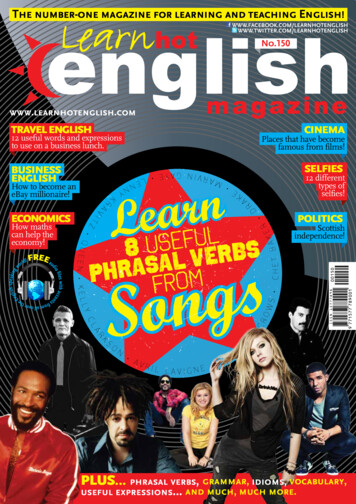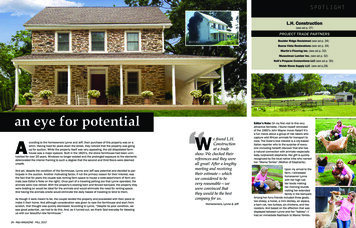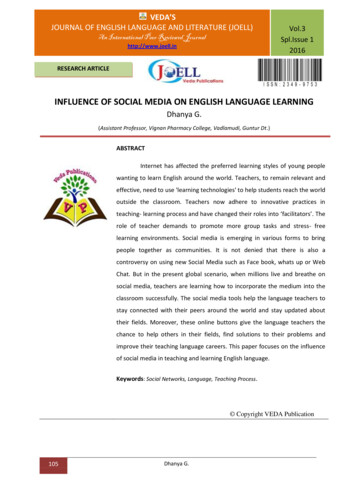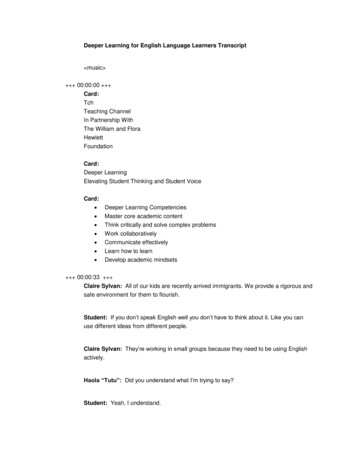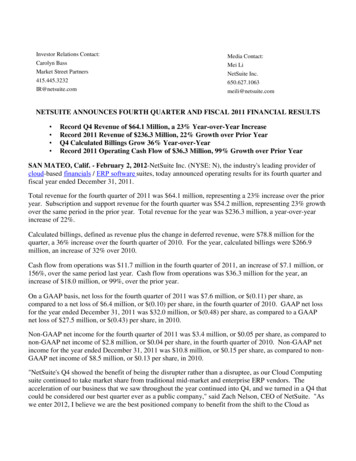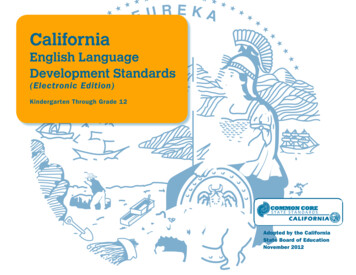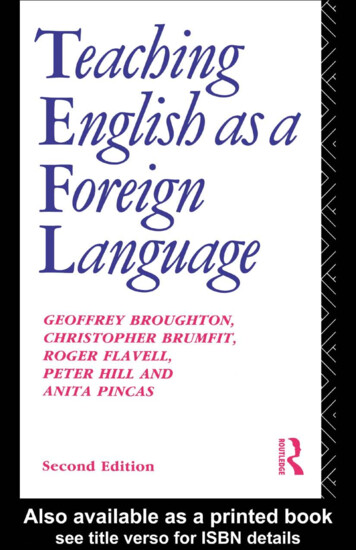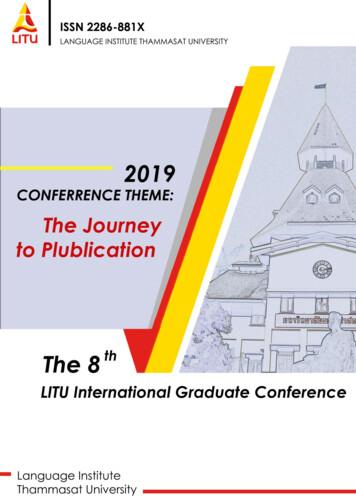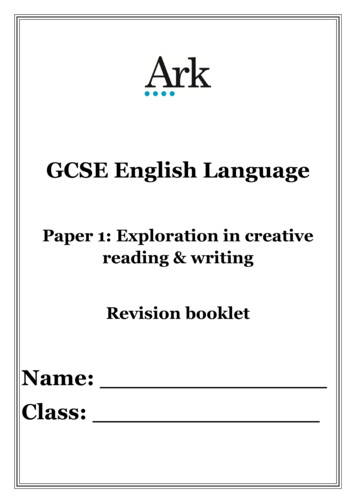
Transcription
English Language Learning MagazineCONTACTApril 2019VOLUME 45 NUMBER 1, April, 2019ISSN # 0227-293Teachers of English as a Second Language Association of azine
IN THIS ISSUEIn this issue . . . . . . . . . . . . . . . . . . . . . . . . . . . . 2CalendarEditor’s Note . . . . . . . . . . . . . . . . . . . . . . . . . . . 3April 6TESL London.http://www.tesllondonorg/?i 13738&mid 1000&id 335957April 11–13BCTEAL. Vancouver, onferenceApril 12TESL Windsor Spring PD workshop:LearnIT2Teach. https://www.teslwindsor.com/workshops.htmlEngaging students in speaking assessment toincrease their participation in speaking activities . 18April 13TESL Hamilton Spring l borrowing among Francophones in theGreater Toronto Area . . . . . . . . . . . . . . . . . . . . . 24May 2–3TDSB Celebrating Linguistic DiversityConference. nglinguistic-diversity-annual-conference/May 10–11REAL Institute. Theory, Applied:Myths and Realities. Toronto,ON. ce/May 25TESL Nova Scotia. ce/May 29–31College Association for Languageand Literacy (CALL). Scarborough,ON. e 1–3Canadian Linguistic Association (ACL/CLA). Vancouver, BC. http://cla-acl.ca/appel-2019-call/June 3–5Canadian Association of AppliedLinguistics (ACLA/CAAL). Vancouver,BC. http://www.aclacaal.org/conference-2019/June 8TOSCON19. Toronto, alsAugust 19–21International Conference on TaskBased Language Teaching. Ottawa, ON.https://carleton.ca/tblt/August 22–24Multidisciplinary Approaches inLanguage Policy & Planning Conference.Toronto, ON. Contact magazine editor search . . . . . . . . . . . . . . 4Contact Magazine . . . . . . . . . . . . . . . . . . . . . . . . 5ArticlesKnowledge mobilization in TESL . . . . . . . . . . . . . 12Teachers as interpreters of research results . . . . . 12Compulsory professional development policy forESL instructors . . . . . . . . . . . . . . . . . . . . . . . . . 30Why teachers need to care about self-care . . . . . . 36-2-TESL Ontario CONTACT Magazine April 2019back
EDITOR’S NOTEThis is my last issue as editor of TESL Ontario’s Contact magazine. My heartfelt thanks goout to all our readers. You are literally the raison d’être of the magazine. And of course, allthe writers who have contributed their ideas and research are its life force. It has been mypleasure to connect these two groups, to put you, if I may, in contact.In 2012, I took over the editorship from Tania Pattison, who served as editor for a yearafter the untimely death of Clayton Graves in 2010. Clayton was editor for seven yearsbefore that. I am grateful to them and to the other editors who went before for their visionand stewardship. I would also like to thank Kevin O’Brien, our advisory board, and otherfolks who have worked behind the scenes to make the magazine and the new(ish) websitewhat it is.Finally, I am most sincerely grateful to my wife, Yoko Reynolds, who has patiently,carefully, and skilfully designed and laid out of all of the issues that I have edited.A call for a new editor has now gone out. You can find it on the next page. I wish the neweditor the very best.A number of the articles in this issue grew from presentations at last fall’s TESL Ontarioconference, which was held November 1 & 2 at the Sheraton Centre, Toronto. The issueopens with a detailed description from John Allan, Jaqueline McMaster, and Keith Hackettof their shift from textbooks to an in-house, digital system for developing, managing, andpublishing course content.Sardar Anwaruddin’s article describes the results of two attempts to increase knowledgemobilization among teachers. He also describes five actors in successful knowledgemobilization and underscores the important role of teachers as interpreters of researchresults.Nermine Abd Elkader presents her ideas about increasing student engagement in speakingactivities by having students employ the meta skills of reflection, and self and peerassessment. Next is an article from Tessa E. Troughton, who investigated lexical borrowingamong Francophones in the Greater Toronto Area and found significantly lower rates oflexical borrowing than the rates reported by previous researchers.Wrapping up the issue, Plamen Kushkiev provides his insights into a compulsoryprofessional development policy at a private language school, and Patrice Palmer discussesthe need for teacher self care.Along with these articles, I strong recommend reading conference report and the paneldiscussions to understand where English teaching in Ontario is headed.Brett Reynoldseditor@teslontario.org-3-TESL Ontario CONTACT Magazine April 2019back
EDITOR SEARCHCONTACT MAGAZINE EDITOR SEARCHPaid contract positionTESL Ontario invites applications for the position of TESL Ontario Contact Editor, a two-year renewable contractposition. The deadline for application is April 23, 2019. We anticipate a starting date of May 21, 2019 or earlier.Orientation for the Summer issue of Contact will be provided by the outgoing Contact Editor.Contact, TESL Ontario’s professional development magazine, was first established in 1974 and has developed into asophisticated, theme-based publication. It is published online three times a year to meet the needs of various ESL/ELDconstituencies represented through the TESL Ontario membership. The readership is drawn from language instructorsand teachers employed in ESL programs offered by community agencies, district school boards, colleges, universitiesand private schools across the elementary, secondary and adult panels.Responsibilities: Soliciting suitable contributions Providing editorial work, layout, and formatting for TESL Ontario’s Contact Magazine Posting each of the articles in the WordPress system as a text document and as a PDF file, complete with artworkand tags Posting of the full complete versions of Contact as PDF files in the online WordPress system along with thenecessary artwork for the articles and the coverSkills required in addition to the editorial skill: Advanced skills in Microsoft Word and WordPress software Ability to create PDF files Ability to create and modify images suitable for the magazineThe Editor receives a fee of 2,900 for each Contact issue upon completion of the work. TESL Ontario pays for theEditor’s TESL Ontario conference fee since this is a unique opportunity to gather material and meet members fromTESL Ontario’s 12 Affiliate Chapters.The Editor reports to TESL Ontario’s Executive Director and works closely with TESL Ontario’s Contact EditorialAdvisory Board.TESL Ontario is particularly interested in receiving applications from individuals who have a recognized ESL/EALteaching and publication record as well as an established record of editorial work. Please review “Contact” under thePublications link on TESL Ontario’s website http://www.teslontario.org/publication for an overview of current andpast issues.Please forward a cover letter, curriculum vitae, and the names and contact information of two individuals who are ableto evaluate your editorial abilities to Renate Tilson, Executive Director, at rtilson@teslontario.org by the deadline of April23, 2019.-4-TESL Ontario CONTACT Magazine April 2019back
CONTACT MagazineVOLUME 45, NUMBER 1, April, 2019CONTACTTESL ONTARIOContact is published three timesa year (April/May, August, andNovember) by TESL Ontario.May is our conference issue. Itis published for the members ofTESL Ontario and is availablefree online to anyone.TESL Ontario is a supportive community empoweringeducational professionals to help English languagelearners to thrive.Contact TESL OntarioTESL Ontario #405 - 27 Carlton St.Toronto, ON M5B 1L2Phone: 416-593-4243 or 1-800-327-4827Fax: 416-593-0164http://www.teslontario.orgContact welcomes articles ofgeneral interest to associationmembers, includingannouncements, reports, articles, and calls for papers.Enquiries regarding membership or change of addressshould be addressed to the TESL Ontario MembershipCoordinator at membership@teslontario.org.PersonnelEditorEAB membersWebmasterDesignBrett ReynoldsHedy McGarrellDavid WoodHanna CabajKevin O’BrienYoko ers-at-largeLegalISSN # 0227-2938The statements made and expressed in articles are thoseof the authors and do not necessarily reflect the policies ofTESL Ontario.Sharon DengDavid HazellArt RekhtinCheryl FretzBrett BasbaumAlex HarchenkoLara McInnisDavid WoodAmy YaniExecutive directorCopyright for all articles published in Contact rests withthe authors, Copyright 2019. Any reprints require thewritten permission of TESL Ontario and must clearlystate Contact as the source along with the original date ofpublication. For permission, contact:rtilson@teslontario.org.Renate TilsonAffiliatesTESL Durham, TESL Hamilton-Wentworth, TESLKingston, TESL London, TESL Niagara, TESL NorthYork/York Region, TESL Northern Region, TESL Ottawa,TESL Peel/Halton/Etobicoke, TESL Toronto, TESLWaterloo-Wellington, TESL WindsorCover design: Copyright 2019 Felisa Nguyen-5-TESL Ontario CONTACT Magazine April 2019back
ARTICLESHACKING THE ESL STUDENT WORKBOOKBy John Allan, Jaqueline McMaster and Keith HackettIn our Technical Trades Program (TCP), we were challenged with designing and creatingstudent books and interactive Learning Objects (LOs) for our foundation students. Thefoundation program trains English as a Foreign Language (EFL) students in trade-specificterminology and provides hands-on workshops. It is essentially a bridging programdesigned to prepare trainees for their programs, which consist of Process Operations,Mechanical Technician Program, Electrical Technician Program, and Instrumentation,all including a common Safety component. The majority of our students are male Qatarinationals whose first language is Arabic.The ChallengeThe first challenge was to find materials that motivated our students and that were at ourstudents’ language level, which was CEFR (Common European Framework of Referencefor Languages) A1 Breakthrough or beginner. It was also a challenge to match courseoutcomes with level-appropriate material and activities. Additionally, their ambitiousschedule and focused career targets pushed us to integrate industrial concepts, scenarios,and vocabulary into our curriculum.Another arduous consideration is our institution’s movement towards Bring Your OwnTechnology (BYOT). We had to design digital materials presented on laptops and handheld devices such as PowerPoint slideshows.With these considerations, we used a backwards design method to design an educationalpractice through establishing learning experience goals before creating instructionalmaterials.This allowed us to reimagine our student book design from the learners’ perspective, andalways being aware of the BYOT model, we integrated blended learning techniques toaddress areas of weakness in our current materials.From a branding point of view, another important factor for us was to maintain a commontemplate, mirroring an important project simultaneously taking place in our engineeringdepartment. English as a Foreign Language department staff were involved in assisting withthe assembly of student workbooks, development of vocabulary lists, review of assessments-6-TESL Ontario CONTACT Magazine April 2019back
ARTICLESand provision of andragogical advice in relation to foreign language teaching and learning.This experience shaped many aspects of our project including workbook template design,vocabulary treatment, QR code linking to external resources, and image sourcing.Development TeamOur development team consisted of experienced educators. Two of them functioned ascurriculum developers and in class instructors. They worked in tandem to generate materialfor classroom and workshop use, and produced student manuals using Microsoft Word,which were later converted into InDesign documents by developers. The developers, whowere certified language instructors as well, collaborated to produce learning objects, sourceimages, generate QR codes, and move all curriculum and materials into new manuals,created with InDesign with interactive learning objects embedded. They developed atemplate for InDesign documents and established target vocabulary for glossaries. Aswell, they developed templates for Captivate and Hot Potato activities and reconstructedtechnical drawings and illustrations.QR Code Readers: Android & IPhoneQR code generators: goQR; QR Code Generator, & QR StuffIn addition to the developers and curriculum writers, our team also included an on-calltechnical advisor who provided on-going support and guidance on several issues, anda departmental audio technologist who recorded all audio sound clips required for ourinteractive learning objects. As this project targeted entry-level English language learners,we also required an Arabic translator who translated all target and technical vocabulary.The translated vocabulary items were also included in Quizlet vocabulary activities forstudent reference.Development ResourcesIt has taken our team a great deal of research, trial, and error as well as negotiation todecide upon our development tools. The tools listed here may change as we are alwayslooking for more efficient means of developing learning objects. The following paragraphsprovide a summary of the features of each of the tools we have used in this project.Adobe Captivate is a tool that excels in creating interactive simulations and assessments.Our team used Captivate for learning events that required simulation and drag and dropassessments. Captivate generates HTML 5 learning ob
foundation program trains English as a Foreign Language (EFL) students in trade-specific terminology and provides hands-on workshops. It is essentially a bridging program designed to prepare trainees for their programs, which consist of Process Operations, Mechanical Technician Program, Electrical Technician Program, and Instrumentation,

